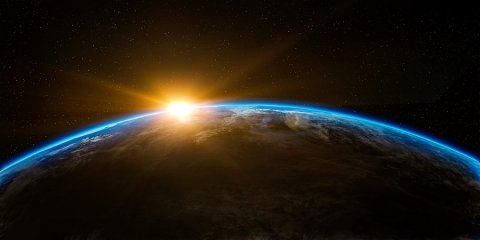Here are some uncomforting statistics. Since 1970:
- our population has doubled (from 3,7 billion to 7,5 billion);
- we are emitting 2,5 times more CO2 (from 14,9 billion to 37 billion tonnes);
- sea ice has melted (13,3% decline per decade);
- sea levels have risen (3,3 mm per year);
- wild animal populations have shrunk (60% decline; over 170 animal species declared extinct).
Today, more than ever before, we need to unite and celebrate one of the most important days in the year - Earth Day. April 22 is a special day when we honour our only home - Mother Earth. The central idea of Earth Day is that to meet economic, social, and environmental needs of current and future generations, we need to live in harmony with nature. The term “Mother Earth”, common in many languages, reflects our dependence and strong relationship between the planet and humanity. Earth Day is also an attempt to raise public awareness on environmental issues and call for solutions to save our planet. Traditionally, Earth Day is celebrated with conferences, rallies, and various outdoor activities.
The first Earth Day dates back to 1970 and was proposed by Senator Gaylord Nelson. After seeing the damage caused by a massive oil spill in Santa Barbara in 1969, he was inspired to educate the public about the environment. In 1970, 20 million Americans celebrated Earth Day delivering to politicians the crucial message about the importance of environmental protection. Later that year, the Environmental Protection Agency was created. Earth Day also contributed to the creation of the following acts:
- The Clean Air Act;
- The Water Quality Improvement Act;
- The Endangered Species Act.
In 1990, Earth Day became a global celebration. In 1995, Nelson was awarded the Presidential Medal of Freedom for being the founder of Earth Day (the highest honour given to civilians in the United States). Earth Day is a day to learn about environmental issues; it reminds people to think about humanity’s values, threats our planet faces, and ways we can protect the environment.

South Ural State University and Environmental Protection
Among the effective ways to tackle the current environmental crisis is the use of alternative energy such as solar power. Despite solar energy being a hot topic, it has recently proved to be hugely beneficial for the environment and businesses. Due to the ever-increasing demand, the solar technology has been consistently improved to get the most out of this clean energy source. South Ural State University is among the world’s promising contributors to the development of solar panels. The project headed by Professor Oleg Rakitin aims to develop materials for new-generation solar panels.
Organic photovoltaics is one of the promising research areas in the field of alternative energy. Organic solar cells are simple in design and non-toxic; they have a short payback period and require minimum substrate amount. South Ural State University is working on the molecular design of photosensitizers for third-generation organic solar cells. The university is developing a comprehensive method for solar energy conversion based on the new dyes designed with the use of chalcogen-nitrogen heterocycles. The new molecular architecture enables to increase the photostability, light absorption, and conversion rate. By broadening the variety of organic semiconductors, the university is paving the way to the future of energy engineering, electronics, and photovoltaics. The designed materials will find their use in non-fuel energy engineering and nonmetal electronics.
One of the considerable advantages of third-generation solar cells is their short payback period compared to the first- and second-generation solar cells. According to the data from Energy and Environmental Science, the payback period for third-generation solar cells takes months, whereas it takes years for solar panels of the previous generations to pay off.
However, the existing third-generation photovoltaic cells are energy-inefficient, with a 12% conversion rate in lab tests. Such inefficiency is due to the low-level hole and electron conductivity and high recombination rate. South Ural State University is planning to develop third-generation solar cells to make them more energy- and cost-efficient by:
- implementing higher chalcogenides that will considerably narrow the band gap;
- enhancing electrical conductivity along the layers of molecular packing.
The project aims to achieve a breakthrough in alternative energy and improve the efficiency of solar cells, increasing the conversion rate to 15%, which is near to the theoretical limit.
Creating clean, renewable power from the sun significantly reduces environmental damage. Solar power dramatically reduces greenhouse gas emissions and, in turn, curbs global temperature rises and climate change. Furthermore, by going solar, we can significantly reduce the level of respiratory diseases and cardiovascular problems.

And finally, here are some comforting statistics. Since 1970:
- key pollutants have decreased (-71%);
- new cars, trucks and buses are over 90% cleaner;
- bald eagles have returned from the brink (from 791 to 9,789);
- production and consumption of ozone-depleting substances have decreased (over 90%);
- the ozone layer has stabilised and begun to recover;
- in 2015, 197 countries agreed to dramatically reduce CO2 emissions.
Earth Day is a day for everybody. Let’s spend this day learning about critical environmental issues, take care of the environment, and make wise choices.




